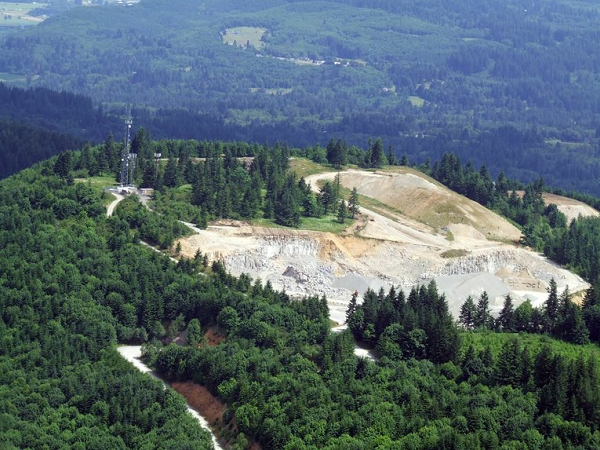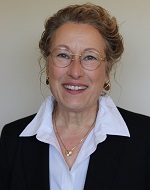Solicita ahora para formar parte de nuestra próxima grupo de Becados en Ciencia científicos comunitarios y líderes comunitarios.

Yacolt Mountain Quarry Aerial View, Photo by The Columbian
The East Fork Community Coalition, led by Dick Leeuwenburg and Marie Ogier, teamed up with AGU scientists to evaluate potential risks associated with the proposed expansion of the Yacolt Mountain Quarry. The resulting output for this first phase of an ongoing project included compiling evidence-based recommendations to include in a package submitted to Clark County on behalf of EFCC to ensure the safety of residents in the area of quarry. In response to the concerns outlined in the “Description Section,” the items below contributed toward ongoing efforts of the EFCC.
Questions and recommendations related to the above topics was submitted to the county in early 2021. Future work on this project may include completing full assessments on the ground to evaluate potential risk to community members in more detail and ensure families in the area stay safe.
Clark County is a county in the southwest corner of Washington State with the Columbia River defining its southern and western borders. Outside of its most populous area of Vancouver, WA, majority of the county is rural and forested. Nested between the Cascade Mountains and the Pacific Coast, the East Fork of the Lewis River, a tributary to the Columbia, cuts through the northern part of the county and provides cold water habitat for endangered Pacific salmonids. Community members describe their home as beautiful and note that their rural lifestyle provides both privacy, a quiet retreat, and endless opportunities for outdoor recreation.
Over the past five years, community members have voiced concerns about the environmental and health impacts from nearby Yacolt Mountain Quarry, where volcanic rock is mined and crushed into gravel and other aggregate. Approximately 1,300 homes are located within 2 miles of the quarry and have complained of loud blasts rattling their homes. Dust and noise generated from the mining operations and truck travel disturbs residents on a daily basis. Residents are also concerned about the impact of the mining on the local aquifer which supplies drinking water and the health of critical salmonid streams. There is a general concern about the impact of the mining operations on drinking water supplies. Dust settles out in people’s homes and there is increased concern over the risk of landslides from the operations. The 2014 mudslide that killed 43 people in Oso, WA remains fresh in people’s memories.
In December 2018, the Clark County Council approved the expansion of the mine to the south to store overburden. Concerns over the quarry’s impacts have only deepened and residents have organized to focus more attention on the issue. An analysis of dust collected inside a home in Battle Ground, WA found dust particles with characteristics similar to Woolly Erionite, a naturally occurring asbestos. When airborne, Woolly Erionite can be inhaled where the fibers become lodged in the lungs, causing respiratory, cardiovascular and increased cancer risk. Residents are concerned that the Woolly Erionite may be associated with the mining activity.
The recently established East Fork Community Coalition (EFCC) is dedicated to protecting families and homes along the East Fork of the Lewis River. They do this by sharing information and communicating concerns about issues facing the area. EFCC’s goal for this project is to gain new information about the impacts that the Quarry is having on the environment and residents in the area. This includes understanding the composition and source of the dust that settles out, how the dust is generated, the risks of continued mining to drinking water, and the potential for landslides.
The first priority for this project will be to engage with a scientist to further understand the composition and source of the dust. Other priorities will addressed in later phases of the project.
Project Impacts: Beneficiaries include community members of all ages who reside near the quarry as well as the natural resources and assets across the landscape. Health risks will be lowered, and the expectation is that the community will know how to mitigate exposure to any risks that the quarry operations may pose. By bringing the community together around a common goal, the community leaders will be able to bring the needs of this community to the forefront of policy- and decision-makers.
Resultados del proyecto:
Outputs include:
Enclavado entre las montañas Cascade y la costa del Pacífico, el condado de Clark, en Washington, es una zona rural y boscosa rica en belleza y recursos naturales. Los amantes de las actividades al aire libre se sienten atraídos por las impresionantes vistas de los ríos Columbia y Lewis y su abundante pesca, mientras que los intereses industriales se ven atraídos por las reservas de roca volcánica de la región, que se extrae y tritura en grava y otros áridos en la cantera de Yacolt Mountain desde 2002.
La minería se considera importante para la economía de la región, pero los residentes se preocupan por su impacto en el medio ambiente, su salud y su calidad de vida. Algunos residentes sostienen que el condado no ha contado con personal adecuado para hacer cumplir la normativa medioambiental, y sospechan que el polvo y el cieno que genera están aportando contaminantes nocivos al aire y a las aguas subterráneas. El aumento de las actividades mineras también ha traído ruido y luz a esta zona antes tranquila y ha incrementado el riesgo de desprendimientos y los peligros para la conducción asociados a los grandes camiones en carreteras pequeñas.
Ahora, una propuesta de ampliación de la cantera ha llevado las tensiones a un punto crítico. Ante esta situación, la Coalición Comunitaria de East Fork (EFCC), un grupo de base de residentes de la bifurcación este del río Lewis, está colaborando con científicos para conocer el impacto ambiental de las actividades mineras y luchar por proteger el lugar que aman.
Hablamos con Marie Ogier, Secretaria de la EFCC, sobre por qué su grupo está tan dedicado a su misión.
¿Cómo describiría el condado de Clark a alguien que nunca ha estado allí?
Es absolutamente precioso. Estamos al norte de Portland, Oregón, justo al otro lado del río Columbia, y mucha gente viene a East Fork para recrearse. Es una excursión fácil. Llevamos a nuestros hijos cuando eran jóvenes-allí era donde pasabas el rato en un caluroso día de verano. Hay parques, bodegas... es una zona preciosa.
¿Cuáles considera que son los puntos fuertes del condado de Clark y de los miembros de su comunidad?
Es una zona muy bonita que atrae a mucha gente que quiere protegerla. El EFCC está formado en su mayoría por profesionales jubilados que llevan muchos años viviendo aquí y tienen firmes convicciones sobre la protección del medio ambiente y de la gente que vive aquí. Todos dedicamos mucho tiempo personal a esto porque estamos firmemente convencidos de que hay que hacerlo.
¿Cuáles cree que son sus retos únicos o sorprendentes?
El condado está pasando verdaderos apuros y ve en el crecimiento de la industria de los áridos una vía para avanzar económicamente. Las dificultades significan que no tienen personal para hacer cumplir sus propios permisos. Tras la presión de varios grupos, por fin han contratado a funcionarios encargados de hacer cumplir las normas, pero sólo tienen dos para todo el condado. Las personas que normalmente protegerían al público están desbordadas. No son malas personas, pero tienen demasiado trabajo.
También hay un abismo real entre nuestro grupo y otros puntos de vista. A la gente se le dice que vamos a por su medio de vida, y no es así. Mi marido trabajó en una empresa de equipos mineros durante 35 años. No estamos en contra de la industria, el crecimiento o el desarrollo, pero queremos que esta cantera en concreto se ponga en conformidad para proteger este río y a la gente que vive aquí.
¿Qué cree que le sorprendería a la gente saber sobre su comunidad?
Es una zona de desprendimientos documentados a ambos lados. Debajo de esta cantera está el río, zonas residenciales, bodegas y otros negocios que son lugares de destino. También en la base de esta cantera hay un banco genético salvaje de trucha arco iris y cuatro especies de salmónidos amenazados o en peligro de extinción, tesoros que el condado se ha gastado más de 23 millones de dólares en restaurar.
¿Qué consejo daría a otros grupos que quieran resolver un problema comunitario?
Mi consejo es que busques otras organizaciones-como Catchafire, Patagonia Action Workso la Fundación Taproot-que pueden enseñarte a ser eficaz, sobre todo en las redes sociales. Catchafire nos ayudó a encontrar tres diseñadores web gratuitos para que pudiéramos educar al público con los datos científicos obtenidos por nuestros contactos científicos en Thriving Earth Exchange. Saber qué pasos hay que dar para que los voluntarios sean más eficientes es muy importante. Una red de otras personas que han hecho activismo de base puede ayudar, sobre todo cuando todos lo hacemos en nuestro tiempo libre.
¿Qué considera prioritario para garantizar que su comunidad sea un gran lugar para vivir dentro de 20 años?
En este momento, es terrible. Las carreteras son peligrosas por los camiones de grava que provocan accidentes y exceso de velocidad, y la trituradora es ruidosa y levanta un polvo que recorre kilómetros. Las explosiones son muy fuertes, y ocurren antes y después de las horas permitidas. La gente está aterrorizada incluso a 3 km de distancia. Una de las granjas cercanas dice que sus clientes entran en pánico cuando se produce una explosión. Caen rocas, arena y escombros con tanta fuerza que tienen que encerrarse en casa. Los niños esperan los autobuses escolares en las estrechas y sinuosas carreteras de las canteras.
Se está destruyendo la apacible habitabilidad de este valle, que es una zona preciosa. Ojalá pudieras ver el musgo de los árboles, las vistas del río y las cataratas. Todos estamos convencidos de que la gente debe dar un paso adelante para ayudar a proteger esta zona. La cantera quiere más que duplicarse. Acaban de comprar 560 acres, y esto no va a desaparecer a menos que lo detengamos. Es un accidente a punto de ocurrir en muchos sentidos. No queremos que la gente se pierda, y no queremos que este río se pierda. No quedan muchos de ellos.
Líderes comunitarios

Dick Leeuwenburg is the president and founding member of the East Fork Community Coalition (EFCC). He has a BS in Industrial Engineering from Stanford University and an MBA from the University of Chicago. Work experience includes a stint as an economist for an international oil company and CEO of a publicly traded corporation. Dick and his wife , Jann, have lived on 35 acres in the valley of the East Fork of the Lewis River for 25 years.

Marie Ogier is the Secretary for EFCC and a former Sales Executive, training sales personnel in business, networking, and management. She has served on the Board for 3 regional non-profits specializing in fundraising, sponsorship, and advocating. As a Community Volunteer and Master Gardener she enjoys collaborating with others for a safe and healthy environment. Living with her husband, Gary, in Clark Co for 31 years, she respects and appreciates the irreplaceable asset of the East Fork of the Lewis River. She is also a founding member of East Fork Community Coalition.
Enlace científico
Dr. Alyssa Shiel is an Assistant Professor in Geology & Geophysics at Oregon State University. She studies heavy stable isotope geochemistry and the environmental fate of metals/metalloids. Bio coming soon!
(c) 2024 Thriving Earth Exchange